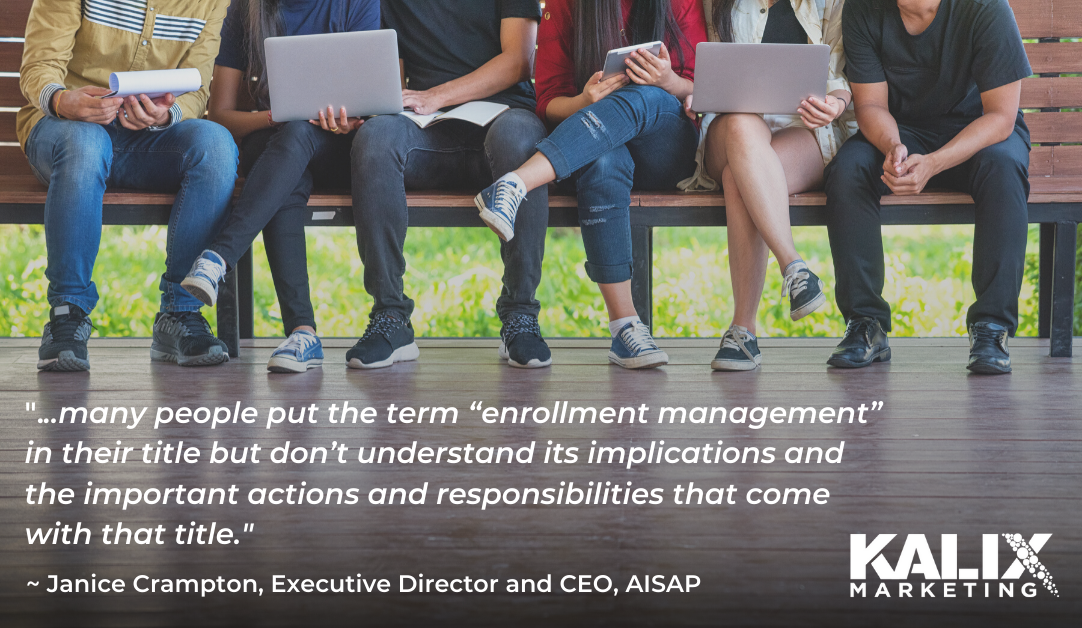Enrollment management is one of the most critical areas for schools and school leaders. This month, we talk with Janice Crampton, Executive Director and CEO of the Association of Independent School Admission Professionals (AISAP) on the importance of enrollment management and how it affects what she calls the “thrive-ability” of a school in the context of mission, vision and finances.
While we spoke with Janice right before schools shifted to remote learning due to the pandemic, her insight and recommendations have never been more relevant.
What enrollment management trends are you seeing?
Janice: The most impactful trend that we’re seeing at AISAP is that more schools are using the term “enrollment management” to not only indicate one’s job responsibility but to discuss the thinking, strategy and implementation of recruitment and retention processes and goals. It’s critical for schools, leadership and the profession to understand what that term means and what is then required to support the operational tools, strategies and planning to be successful.
We see many people put the term “enrollment management” in their title but don’t understand its implications and the important actions and responsibilities that come with that title. Whether you are an admission professional or an enrollment management professional, your school must practice enrollment management strategies. The action and mindset ensure institutional success.
How do you define enrollment management?
Janice: At AISAP, we define enrollment management as:
- An institutional response to the challenges and opportunities that recruiting and retaining the right student body present to a school’s financial health, image and student quality;
- A research-based process that creates a synergy among recruitment, pricing and financial aid, academic program, student life and constituent relations; and
- Essential for revenue optimization and encompasses these key areas.
Now more than ever, training and support for those responsible for recruitment and retention cannot be effective unless they are: 1) educated; 2) elevated in terms of expectations of performance and role at the school; and 3) empowered through support, leadership training and business acumen.
What external trends impact enrollment management?
[Editor’s note: These trends were discussed pre-pandemic but are still relevant.]
Janice: There are institutional trends clearly driven by things out of our control. Schools may want stronger enrollment in lower grades, but the birth rate doesn’t allow for that. Juxtapose the declining numbers of younger students with the financial implications of fewer students and the consumer mindset with purchasing choices. Millennials are making decisions to use their money in certain ways.
Enrollment trends need to marry up with [a school’s] business needs and internal desire. Right sizing for a school is critical. Schools need to better understand this, which is hard for schools. The word “change” and schools often are not used in the same sentence.
Schools need to think of themselves in the long term. There will be moments of small [enrollment] and moments of large. Sometimes development will drive revenue, and sometimes enrollment will drive it. What is the right size for your school in 2020? The maximum enrollment? What’s the minimum needed to function? If enrollment is viewed as a financial lever and as a mission lever, that’s when the magic comes together.
How can schools best position themselves to embrace these trends?
Janice: Schools need to clearly understand their place in the market and the customer’s wants and needs. What is their institutional value-added? What problem does attendance and graduation from their institution solve for the customer? Remember: You are not recruiting new students. You are recruiting new students to be graduates.
When we ask the latter, schools often say that they can’t answer it because, “[they] solve a lot of different problems.” But in the absence of plenty, everyone is going after the same. This is where we see the beauty of a very specific mission of a school. With millennials, authenticity is key. In the absence of a family understanding the value-add of your school, they will turn to price as their deciding factor. You’ve done all the work, had great conversations about goodness of fit and, at the end of the day, you are losing [a student] on price?
Schools need to be equipped to converse around price – financial aid, tuition setting and payment methods. Enrollment managers are experienced professionals who should be involved in the school’s conversations about these issues.
What are best-practice strategies to involve the head of school in the admissions and enrollment process?
Janice: Sometimes the best thing is for the head of school to listen and understand when to be the carrier of the mission and when to stand in front or behind [the enrollment office]. I push back on the idea that “enrollment management is everyone’s job.” I believe it is everyone’s role to contribute and to advance the end goals that are actualized in enrollment, but there must always be a sense of who is, in fact, overseeing, managing and ensuring that the plan is being carried out in the context of what the head of school must oversee and manage: the mission, vision and finances.
Think about a candidate’s file. There are various aspects of the file that others play a part in – the application, an assessment, a recommendation, the interview, the tuition payment, the health forms. They are contributors to the applicant’s process, but the admission and enrollment management professional own that file and oversee the process from beginning to end. The same thinking relates to admission and enrollment management – lots of contributions, lots of voices, lots of aspects to consider, but in the end, the admission and enrollment office must bring all of this to fruition in the context of the institution’s mission, vision and strategic plan.
For heads of school, the best practice is training your admission and enrollment management staff and expecting much of them. They need the tools, strategies – long-term and short-term – to present goals and objectives and serve the mission. Heads should expect that these various elements and aspects of the job are understood. If an admission and enrollment management person says that he or she doesn’t know how to do something, heads should make sure that person gets training and make sure that someone at the school does that task. Not knowing how to do something and not doing it cannot be the reason for not having it. This is critically important work, and we cannot afford (literally) shortcuts or back-burner thinking.
Heads, presidents and boards need to understand that, just as you want to hire the best faculty and senior leaders, you need to hire the best admission and enrollment management professionals. The only way they are going to be their best is if they are supported to be their best.
How does AISAP help admission and enrollment management professionals be their best?
Janice: AISAP is the primary teaching organization for those in admission and enrollment management. That is all that we do. We know admission and enrollment management professionals, and we expect much of them because we know they have much to give. But they need to be trained, evaluated and supported. This becomes the difference between doing the tasks of admission and supporting and leading their head of school and leadership into the future. AISAP teaches people what they need to know for the day-to-day and strategic tasks as well as the training towards leading and developing the full leadership team on enrollment management as an industry.
Read about AISAP’s learning and development framework.
Are there shifting expectations for this process as schools’ parent constituency shifts from Gen X to Millennials? If so, how can an Admissions Office best manage this shift?
Janice: What’s interesting is the change and shift when the person who is the admission and enrollment manager is a Gen Xer who is meeting with a millennial parent, or the admission and enrollment manager is a millennial working with a Gen X head of school and faculty. The “do unto others as you would like to have done unto you” does not work. You need to understand perspectives. It is NOT about you. You must understand your parent constituents as customers to your school and understand your faculty, staff and administrators to provide a more effective and impactful process.
Studies, like the one that Kalix Marketing has done, show us that millennial parents want their child to stand out but don’t want advertisements. Yet schools are still operating with ads in the paper as their sole outreach. Why? Because that is the way they have always done it. Not a good data answer.
Perhaps advertising in the local paper helps to retain families? How many times have we heard from present parents when an ad from a cross application school was posted and your school was not there? The tool – advertising in the paper has a place. Just use it for what it is: a point of pride for existing parents.
Admissions and enrollment managers need to better understand what they want to say and what families are really interested in to find the overlapping relevance. As the carriers of the message and strategy, everyone at the school needs to be on board with what millennial parents want. There needs to be a shared, aligned vision. Schools might be doing ads in magazines and lawn signs, but perhaps millennials parents want video and Facebook posts. We need to make informed decisions based on data and think about the value-add of our schools, to make sure it’s a good fit – data-driven dreaming, not dreaming in hopes of achieving the goal.
Download a free copy of the Kalix study.
 About Janice Crampton, CAEP, AEMP
About Janice Crampton, CAEP, AEMP
As AISAP’s CEO/Executive Director since 2007, Janice Crampton brings more than 35 years of experience in school and university enrollment management to AISAP’s mission of supporting and advancing admission and enrollment management professionals in their responsibilities for advancing institutional mission and financial sustainability.
Under Janice’s leadership, AISAP has developed the guidelines and standards for the enrollment management industry and created the Admission and Enrollment Management Professional program, which includes the Certification for Admission and Enrollment Management Professionals (CAEP), the first and only certification program for the industry. She is a sought-after speaker on admission and enrollment management and leadership and on operational needs and strategies involved in admission and enrollment management around the globe.
A graduate of Bucknell University, and leadership and management coursework from Harvard Business School Online, she had her first admission position with Bucknell University and also has served with the State of New Jersey Department of Higher Education, as director of admission and financial aid at Gill St. Bernard’s School, as director of college counseling at Francis Parker School in California, Greenwich Academy, The Williams School and The Country School where she was director of external relations overseeing enrollment, development, parent relations and event planning for 12 years. Janice has served as a member of the Board of Directors for the A Better Chance Program (ABC) and several independent and private schools in her area and presently serves on the ISAnet Board of Directors and is active in her association work serving on the ASAE Small Staff Advisory Council.
For more information on AISAP, visit https://www.aisap.org/home.



